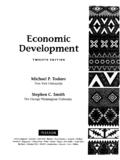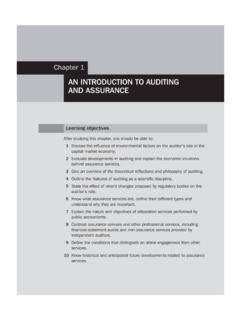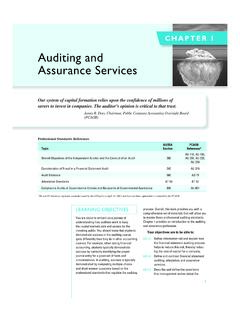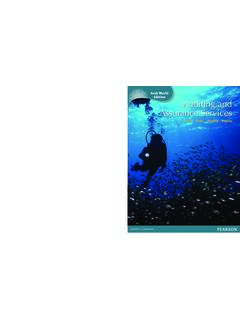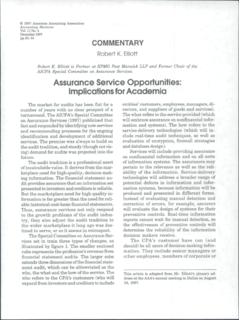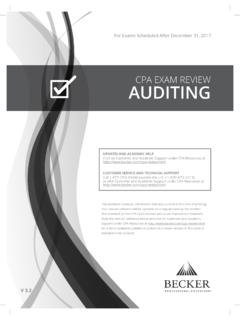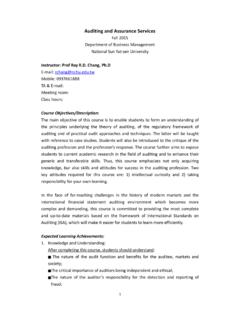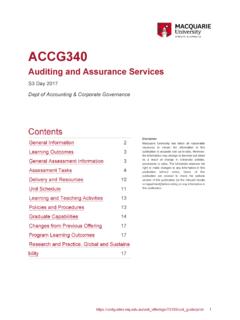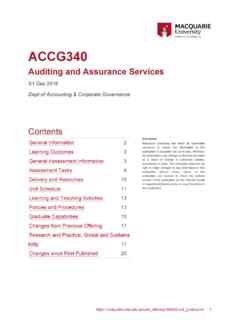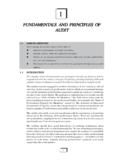Transcription of Auditing & Assurance Timothy J. Louwers, PhD, …
1 Auditing & Assurance services Timothy J. Louwers, PhD, CPA, CISA, CIA, CFF Jackson E. Ramsey Centennial Chair in Business James Madison University Robert J. Ramsay, PhD, CPA Arthur Andersen Alumni Professor of Accounting The University of Kentucky David H. Sinason, PhD, CPA, CIA, CFE, CFSA, CRMA PwC Professor of Accountancy Northern Illinois University Jerry R. Strawser, PhD, CPA KPMG Chair of Accounting Texas A&M University Jay C. Thibodeau, PhD, CPA Rae D. Anderson Professor of Accounting Bentley University Mc Graw Hill Education Contents PART OME THE CONTEMPORARY Auditing ENVIRONMENT Chapter I Auditing and Assurance services 1 User Demand for Reliable Information 2 Information and Information Risk 2 Auditing , Attestation, and Assurance services 4 Definition of Financial Statement Auditing 4 Attestation Engagements 6 Assurance services 8 Examples of Assurance services 9 Managements Financial Statement Assertions 11 Existence or Occurrence (Existence, Occurrence) 12 Rights and Obligations (Rights and Obligations) 14 Completeness (Completeness, Cutoff)
2 14 Valuation and Allocation (Accuracy or Valuation) 14 Presentation and Disclosure (Classification, Understandability) 15 Importance of Assertions 16 Professional Skepticism 17 Public Accounting 20 Assurance services 21 Tax services 22 Consulting and Advisory services 23 Other Kinds of Engagements and Information Professionals 23 Internal Auditing 24 Governmental Auditing 24 Regulatory Auditors 25 Become a Professional and Get Certified! 26 Education 26 Examination 26 Experience 27 State Certificate and License 28 Skill Sets and Your Education 29 Summary 30 Key Terms 30 Multiple-Choice Questions for Practice and Review 31 Exercises and Problems 35 Chapter 2 Professional Standards 39 Introduction 40 Generally Accepted Auditing Standards (GAAS) 41 Fundamental Principle: Responsibilities 45 Fundamental Principle: Performance 49 Fundamental Principle.
3 Reporting (AU 700, AU 705, AS 1, AS 5) 56 Evaluating the Quality of Public Accounting Firms' Practices 58 System of Quality Control 58 PCAOB Inspection of Firms 60 Summary 63 Key Terms 63 Multiple-Choice Questions for Practice and Review 64 Exercises and Problems 68 Appendix 2A Referencing Professional Standards 75 PART TWO THE FINANCIAL STATEMENT AUDIT Chapter 3 Engagement Flanning 77 Introduction 78 Pre-Engagement Activities (AU 300, AS 10) 78 Client Acceptance or Continuance 79 Compliance with Independence and Ethical Requirements 81 Engagement Letters 82 Audit Plan (AU 300, AS 10) 84 Staffing the Audit Engagement 85 Considering the Work of Internal Auditors (AU 610) 85 Using the Work ofan Audit Specialist (AU 620) 86 Use oflT Auditors 87 Time Budget 87 Materiality (AU 320, AS 11) 88 Materiality Calculation 90 Audit Procedures for Obtaining Audit Evidence (AU 500, AS 15) 92 1.
4 Inspection of Records and Documents 94 2. Inspection ofTangible Assets 97 3. Observation 97 4. Inquiry 97 5. Confirmation 98 6. Recalculation 98 7. Reperformance 98 8. Analytical Procedures 98 Flanning in a Computerized Environment 100 Effect of Client 's Computerized Processing on Audit Planning 101 ix x Contents Audit Documentation (AU 230, AS 3) 105 Permanent Files 106 Current Files 106 Audit Documentation Arrangement and Indexing 107 Summary 110 Key Terms 110 Multiple-Choice Questions for Practice and Review 111 Exercises and Problems 115 Chapter 4 Management Fraud and Audit Risk 118 Introduction 119 Managements Responsibility for Risk Management 120 Enterprise Risk Management 120 Auditor's Risk Assessment (AU 315, AS 12) 123 Fraud (AU 240, AU 316)
5 124 Types of Fraud 126 Other Definitions Related to Fraud 128 The Audit Risk Model (AU 320, AS 8) 130 Audit Risk 130 Inherent Risk 130 Control Risk 130 Detection Risk 131 Risk Model A Summary 131 Assessing Inherent Risk "What Could Go Wrong?" (AU 315, AS 72) 134 Understanding the Client''s Business and Its Environment 136 Industry, Regulatory, and Other External Factors 136 The Nature of the Company 137 Related Parties 138 Selection and Application of Accounting Principles, Including Related Disclosures 138 Company Objectives, Strategies, and Related Business Risks 139 Company Performance Measures 139 Gathering Information, Assessing and Responding to Risks 140 General Business Sources 140 Company Sources 140 Information from Client Acceptance or Continuance Evaluation, Audit Planning, PastAudits, and Other Engagements 140 Preliminary Analytical Procedures (AU 520, AU 329)
6 141 Audit Team Discussions (Brainstorming) 146 Inquiry of Audit Committee, Management, and Others within the Company 146 Assessing Risk Factors 147 Respond to Significant Risks (AU 330, AS 15) 147 Evaluate Accumulated Results of Audit Procedures 148 Communicate Fraud Risks 148 Document Risk Assessment 149 Auditors' Responsibilities for Noncompliance with Laws and Regulations (AU 350, AS 17) 149 Audit Strategy Memorandum 151 Summary 152 Key Terms 152 Multiple-Choice Questions for Practice and Review 153 Exercises and Problems 158 Appi;; ' 4A Selected Financial Ratios 167 Appcn ix 4M Sample Audit Memorandum 168 Chaptsr S Risk Assessment: Internal Control Evaluation 171 Introduction 172 Internal Control Defined 173 Management versus Auditors' Responsibility for Internal Control 174 Auditors'Internal Control Responsibilities 175 Components of Internal Control 178 Control Environment 178 Risk Assessment 180 Control Activities 181 Information and Communication 185 Monitoring 186 Internal Control Evaluation 187 Phase 1: Understand and Document the Client's Internal Control 188 Phase 2: Assess the Control Risk (Preliminary) 194 Phase 3.
7 Identify Controls to Test and Perform Tests of Controls 194 Responsibilities in Public Company Audits Required by PCAOB Auditing Standard No. 5 198 Requirements 198 Auditor Reports on Internal Control over Financial Reporting 202 Modifications to the Auditors' Standard Report on Internal Control over Financial Reporting 202 Material Weaknesses in the Entity 's Internal Control over Financial Reporting 204 Effect ofan Adverse Opinion on Internal Control on the Auditor's Opinion on the Financial Statements 205 Restriction on the Scope of the Engagement 205 Other Report Modifications 206 Internal Control Communications 208 Summary 209 Key Terms 210 Multiple-Choice Questions for Practice and Review 211 Contents xi Exercises and Problems 215 Appendix 5A Audit Plan 220 Chapter 6
8 Employee Fraud and the Audit of Cash 221 Employee Fraud Overview 222 Employee Fraud Red Flags 223 Characteristics of Fraudsters 224 The Fraud Triangle (AU 315, AS 12) 226 Motivation 226 Opportunity 227 Rationaliza on 228 Fraud Prevention 228 Managing People Pressures in the Workplace 229 Internal Control Activities and Employee Monitoring 229 Integrity by Example and Enforcement 231 Cash Internal Control Considerations 232 Control Activities for Cash Receipts 232 Tests of Controls over Cash Receipts 235 Control Considerations for Cash Disbursements 235 Tests of Controls over Cash Disbursements 236 Risk of Material Misstatement at the Relevant Assertion Level 236 Audit Evidence Used to Test Cash 237 Cash Receipts Journal 237 Cash Disbursements Journal 238 Bank Reconciliations 238 Canceled Checks 238
9 Bank Statements 240 The Audit of Cash 241 Bank Reconciliation 241 Schedule of Interbank Transfers 245 Proofof Cash 246 Audit Cases: More Schemes and Ways to Detect Them 247 "Extended Procedures" to Detect Fraud 249 Summary 252 Key Terms 253 Multiple-Choice Questions for Practice and Review 254 Exercises and Problems 257 Appendix 6A Internal Control Questionnaires 267 Appendix 6B Audit Plans 269 Chapter 7 Revenue and Collection Cycle 270 Introduction 271 Overall Audit Approach for the Revenue and Collection Cycle 271 Inherent Risks in the Revenue and Collection Cycle 273 Revenue Recognition 273 Collectability of Accounts Receivable 275 Customer Returns and Allowances 2 75 Revenue and Collection Cycle.
10 Typical Activities 276 Entity-Level Controls 276 Receiving and Processing Customer Orders, Including Credit Granting 277 Delivering Goods and services to Customers 278 Billing Customers and Accounting for Accounts Receivable 278 Audit Evidence in Management Reports and Data 279 Control Risk Assessment 281 Control Considerations 281 Tests of Controls 282 Summary: Control Risk Assessment 284 Substantive Procedures in the Revenue and Collection Cycle 285 Analytical Procedures 286 Confirmation of Accounts and Notes Receivable 287 Alternative Procedures 291 Review for Collectability 291 Cutoff and Sales Returns 292 Rights and Obligations 292 Presentation and Disclosure 293 Some Notes about Confirmations 293 Audit Risk Model Summary 294 Audit Cases.






